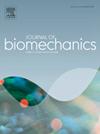Creep deformation of the viscoelastic lumbar tissues: Effects of trunk flexion posture, exposure-recovery schedule, and individual flexibility
IF 2.4
3区 医学
Q3 BIOPHYSICS
引用次数: 0
Abstract
In-vivo human experiments have previously shown significant effects of trunk flexion angle and exposure-recovery schedule on the creep response of the viscoelastic tissues of the lumbar spine. In the current study we explore the effects of trunk flexion, exposure-recovery schedules, and lumbar flexibility on this creep response. Sixteen participants, categorized into two groups based on lumbar flexibility (GROUP: low-flexible, high-flexible), performed four 30-minute protocols consisting of alternating periods of trunk flexion (exposure) and periods of upright standing (recovery). On four different days, combinations of two trunk flexion postures (POSTURE: Max, SubMax) and two exposure-recovery schedules (ER: Long (3 min:6 min), Short (1 min:2 min)) were tested. Trunk flexion–extension motions were performed before/after the 30-minute protocol to capture the changes in peak lumbar flexion angles and changes in the angles of flexion-relaxation in L3/L4 paraspinals that resulted from the protocols. The analysis of lumbar flexibility showed that the low-flexible group had significantly greater changes in the L4 flexion-relaxation angle in the Max posture (Δ2.2°) than in the SubMax posture (Δ1.0°), while the high-flexible group showed no POSTURE effect, indicating a POSTURE × GROUP interaction. In addition, the high-flexible group exhibited greater creep responses in the Short (1:2) condition (Δ2.5°) than in the Long (3:6) condition (Δ0.6°) while the low-flexible group showed no ER effect, denoting an ER × GROUP interaction. Collectively, these results support the complex, multi-dimensional nature of viscoelastic creep responses, and particularly note the impact of an individual’s lumbar flexibility in these responses.
体内人体实验显示,躯干屈曲角度和暴露-恢复计划对腰椎粘弹性组织的蠕变反应有显著影响。在本研究中,我们探讨了躯干屈曲、暴露-恢复计划和腰椎灵活性对这种蠕变反应的影响。16 名参与者根据腰部柔韧性分为两组(组别:低柔韧性组、高柔韧性组),分别进行了四个 30 分钟的训练,其中包括交替的躯干屈曲期(暴露期)和直立期(恢复期)。在四个不同的日子里,测试了两种躯干屈伸姿势(姿势:最大、次最大)和两种暴露-恢复时间表(ER:长(3 分钟:6 分钟)、短(1 分钟:2 分钟))的组合。在 30 分钟方案前后进行了躯干屈伸运动,以捕捉方案导致的腰部屈伸角度峰值的变化和 L3/L4 棘突旁屈伸松弛角度的变化。对腰部灵活性的分析表明,低灵活性组在最大姿势(Δ2.2°)下的 L4 弯曲松弛角度变化明显大于次最大姿势(Δ1.0°)下的变化,而高灵活性组没有显示出姿势效应,这表明姿势 × 组之间存在交互作用。此外,高柔韧性组在短(1:2)条件下的蠕动反应(Δ2.5°)大于长(3:6)条件下的蠕动反应(Δ0.6°),而低柔韧性组没有表现出ER效应,这表明存在ER × GROUP交互作用。总之,这些结果证明了粘弹性蠕变反应的复杂性和多维性,并特别指出了个人腰部灵活性对这些反应的影响。
本文章由计算机程序翻译,如有差异,请以英文原文为准。
求助全文
约1分钟内获得全文
求助全文
来源期刊

Journal of biomechanics
生物-工程:生物医学
CiteScore
5.10
自引率
4.20%
发文量
345
审稿时长
1 months
期刊介绍:
The Journal of Biomechanics publishes reports of original and substantial findings using the principles of mechanics to explore biological problems. Analytical, as well as experimental papers may be submitted, and the journal accepts original articles, surveys and perspective articles (usually by Editorial invitation only), book reviews and letters to the Editor. The criteria for acceptance of manuscripts include excellence, novelty, significance, clarity, conciseness and interest to the readership.
Papers published in the journal may cover a wide range of topics in biomechanics, including, but not limited to:
-Fundamental Topics - Biomechanics of the musculoskeletal, cardiovascular, and respiratory systems, mechanics of hard and soft tissues, biofluid mechanics, mechanics of prostheses and implant-tissue interfaces, mechanics of cells.
-Cardiovascular and Respiratory Biomechanics - Mechanics of blood-flow, air-flow, mechanics of the soft tissues, flow-tissue or flow-prosthesis interactions.
-Cell Biomechanics - Biomechanic analyses of cells, membranes and sub-cellular structures; the relationship of the mechanical environment to cell and tissue response.
-Dental Biomechanics - Design and analysis of dental tissues and prostheses, mechanics of chewing.
-Functional Tissue Engineering - The role of biomechanical factors in engineered tissue replacements and regenerative medicine.
-Injury Biomechanics - Mechanics of impact and trauma, dynamics of man-machine interaction.
-Molecular Biomechanics - Mechanical analyses of biomolecules.
-Orthopedic Biomechanics - Mechanics of fracture and fracture fixation, mechanics of implants and implant fixation, mechanics of bones and joints, wear of natural and artificial joints.
-Rehabilitation Biomechanics - Analyses of gait, mechanics of prosthetics and orthotics.
-Sports Biomechanics - Mechanical analyses of sports performance.
 求助内容:
求助内容: 应助结果提醒方式:
应助结果提醒方式:


